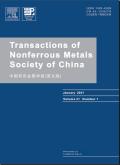基于机器学习的铅冶炼厂土壤污染快速检测与风险评估
IF 4.7
1区 材料科学
Q1 METALLURGY & METALLURGICAL ENGINEERING
Transactions of Nonferrous Metals Society of China
Pub Date : 2024-09-01
DOI:10.1016/S1003-6326(24)66595-7
引用次数: 0
摘要
利用便携式 X 射线荧光光谱仪(XRF)测量了 207 个土壤样本的重金属含量,并将六个环境因素作为模型修正系数,建立了七种重金属的一般预测模型。采用极端梯度提升(XGBoost)模型拟合重金属含量与环境特征之间的关系,以评估冶炼场地的土壤生态风险。结果表明,针对铅、镉和砷建立的广义预测模型准确度很高,拟合系数(R2)分别为 0.911、0.950 和 0.835。表层土的生态风险最高,由于镉的高流动性,在一些不同深度的位置存在较高的潜在生态风险。总体而言,机器学习的应用大大提高了 pXRF 测量的准确性,并确定了关键的环境因素。经过调整的潜在生态风险评估强调了在未来的场地修复工作中重点关注铅、镉和砷的必要性。本文章由计算机程序翻译,如有差异,请以英文原文为准。
Rapid detection and risk assessment of soil contamination at lead smelting site based on machine learning
A general prediction model for seven heavy metals was established using the heavy metal contents of 207 soil samples measured by a portable X-ray fluorescence spectrometer (XRF) and six environmental factors as model correction coefficients. The eXtreme Gradient Boosting (XGBoost) model was used to fit the relationship between the content of heavy metals and environment characteristics to evaluate the soil ecological risk of the smelting site. The results demonstrated that the generalized prediction model developed for Pb, Cd, and As was highly accurate with fitted coefficients (R2) values of 0.911, 0.950, and 0.835, respectively. Topsoil presented the highest ecological risk, and there existed high potential ecological risk at some positions with different depths due to high mobility of Cd. Generally, the application of machine learning significantly increased the accuracy of pXRF measurements, and identified key environmental factors. The adapted potential ecological risk assessment emphasized the need to focus on Pb, Cd, and As in future site remediation efforts.
求助全文
通过发布文献求助,成功后即可免费获取论文全文。
去求助
来源期刊
CiteScore
7.40
自引率
17.80%
发文量
8456
审稿时长
3.6 months
期刊介绍:
The Transactions of Nonferrous Metals Society of China (Trans. Nonferrous Met. Soc. China), founded in 1991 and sponsored by The Nonferrous Metals Society of China, is published monthly now and mainly contains reports of original research which reflect the new progresses in the field of nonferrous metals science and technology, including mineral processing, extraction metallurgy, metallic materials and heat treatments, metal working, physical metallurgy, powder metallurgy, with the emphasis on fundamental science. It is the unique preeminent publication in English for scientists, engineers, under/post-graduates on the field of nonferrous metals industry. This journal is covered by many famous abstract/index systems and databases such as SCI Expanded, Ei Compendex Plus, INSPEC, CA, METADEX, AJ and JICST.

 求助内容:
求助内容: 应助结果提醒方式:
应助结果提醒方式:


